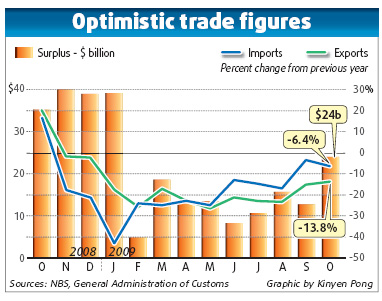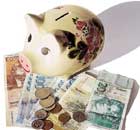Top Biz News
Strong data shows recovery is on track
By Si Tingting and Lan Lan (China Daily)
Updated: 2009-11-12 08:48
 |
Large Medium Small |
The world's third-largest economy looks to be well on the road to recovery, say analysts, following the publication of more strong economic data.
Spurred on by the government's massive stimulus package, industrial production rose in October by 16.1 percent compared to its level of a year earlier. It was the biggest growth in industrial output since March 2008, the National Bureau of Statistics (NBS) said yesterday.
Retail sales - the main gauge of consumer spending and a key ingredient in boosting the economy - rose by 16.2 percent. The jump in retail sales was the biggest surge since December.
|
 Sheng laiyun |
Government stimulus initiatives, including rebates on so-called white goods and tax cuts for low-emission cars, helped ensure China's car sales rose by 43.6 percent in October. Sales of home appliances were also brisk, growing by 35.4 percent.
"Based on the October data, we are more convinced that the government's growth target of 8 percent is well within easy grasp for 2009," said NBS spokesperson Sheng Laiyun.
Domestic consumption will contribute more to growth in the coming months, he predicted, with the New Year Holiday and Spring Festival set to herald a new round of consumer spending.
Analysts said the data confirmed the fact that the economy was on track.
However, China's central bank said yesterday that lending growth slowed in October, which suggests the government is beginning to slow its aggressive monetary policy in a bid to avoid asset-price bubbles.
New bank loans dropped to 253 billion yuan ($37 billion) in October, the lowest monthly level this year, the central bank said.
"The decline in new lending is a result of the sharp decline in short-term loans, which were used by many investors to make short-term gains on the stock market," said analyst Liu Junyu from China Merchants Bank in Shenzhen. "I think it's a sign that the government is starting to make its exit strategy away from the easy monetary policy."
Justin Yifu Lin, chief economist and vice-president of the World Bank, suggested the time was right for China to restrict lending. But he said a proactive fiscal policy was also needed to consolidate the recovery.
"The government should continue to adopt proactive fiscal policies and seek projects with high growth potential," he told China Daily yesterday.
Consumer prices
China's consumer prices fell 0.5 percent in October from a year earlier, the smallest drop since declines began in February. Producer prices went down by 5.8 percent, according to the NBS.
The slower-than-expected growth in consumer prices was largely the result of a sufficient supply of vegetables and fruit during harvest season in October, said Sheng. Food prices account for one-third of China's consumer prices.
Inflationary pressure
Some analysts have expressed concern that China's 4 trillion yuan ($586 billion) stimulus spending package and its very easy liquidity conditions could add to inflationary pressures in the months ahead.
"Rapid money supply growth led to inflation in 2004 and 2008," said Michael Jones from the Riverfront Investment Group. "It could happen again."
He is predicting the rate of inflation could rise as high as 7 percent next year.
|
 |













